This post may contain affiliate links. Please read our disclosure policy.
4 methods for how to juice turmeric with and without a juicer – perfect for making wellness shots, juices, and freezing for later use. Plus, how to use the leftover pulp, and several FAQs!
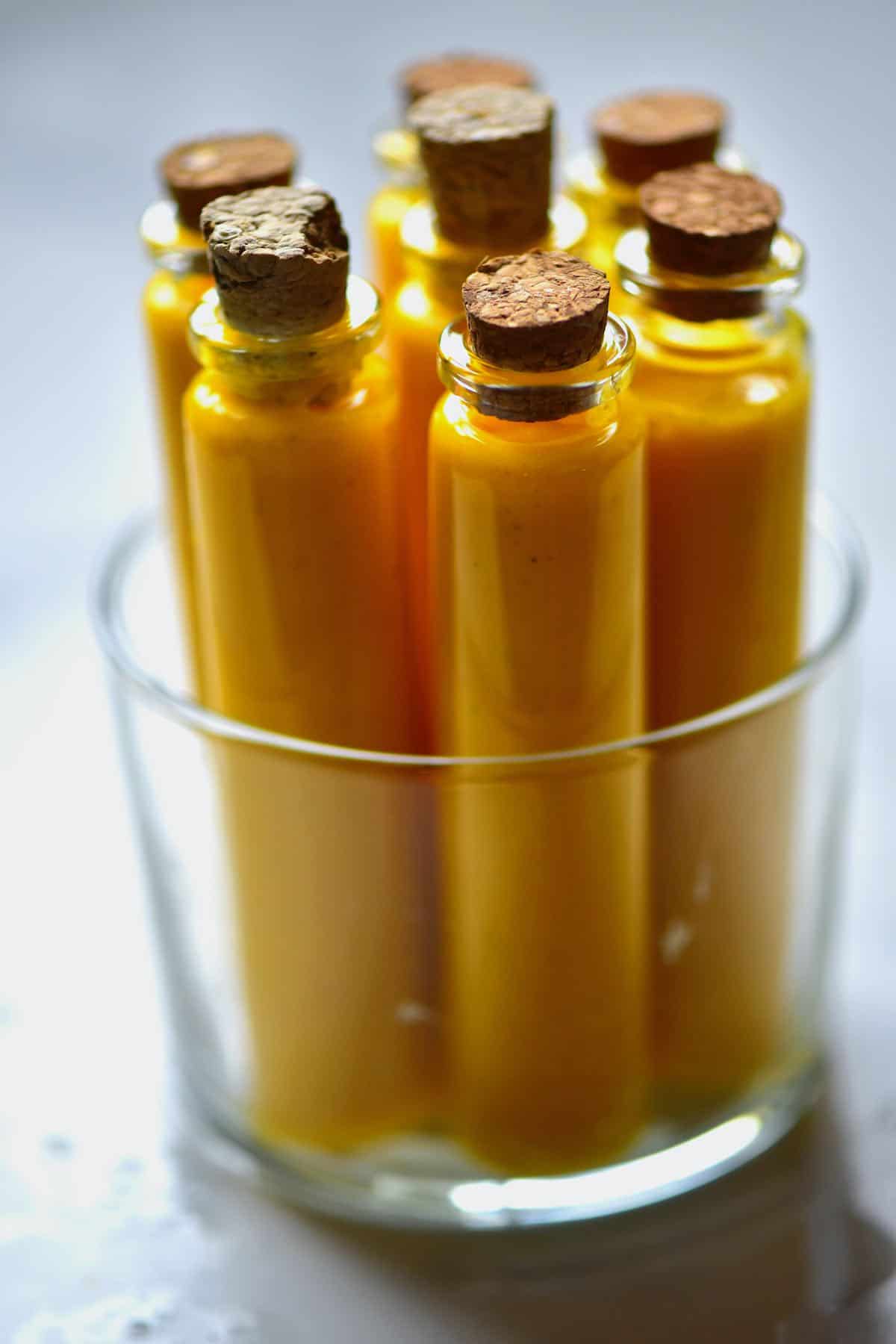
It’s no secret that I’m relatively obsessed with turmeric and its magical compound ‘curcumin’. I’ve already shared methods for Ginger Turmeric Immune-Boosting Shots. Yet, I’ve never shared the absolute basics – how to get turmeric juice!
Turmeric juice can create wellness ginger shots and mixed juices fit for a king (or queen). Plus, there’s no need to throw away the leftover pulp either!
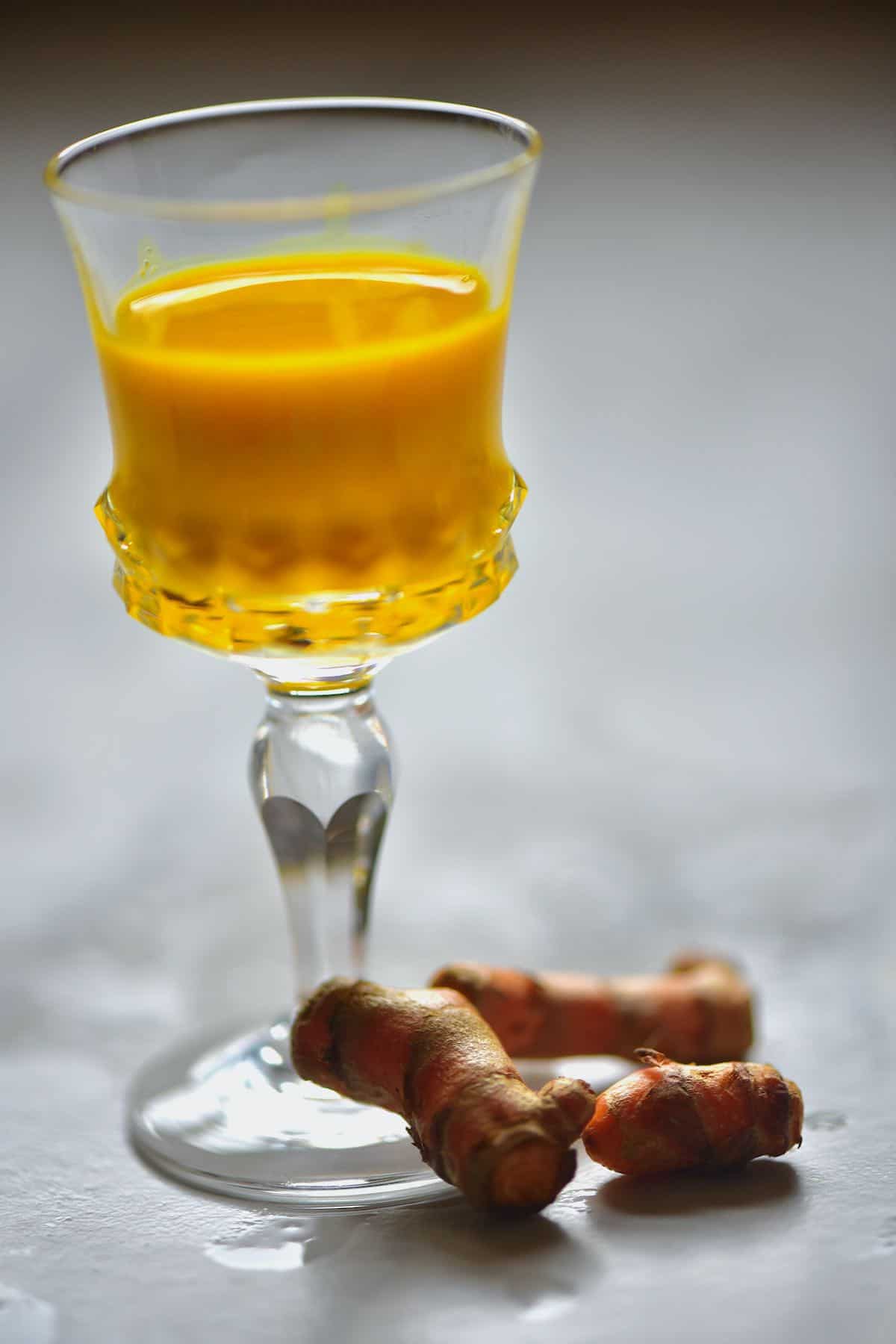
The only caveat is that curcumin isn’t well absorbed into the bloodstream when consumed alone. Instead, any time you consume it, make sure to pair it with an ingredient that will improve curcumin absorption and make the most of the turmeric.
For example, fresh black pepper (which contains piperine) or fats (like coconut oil) can enhance curcumin absorption!
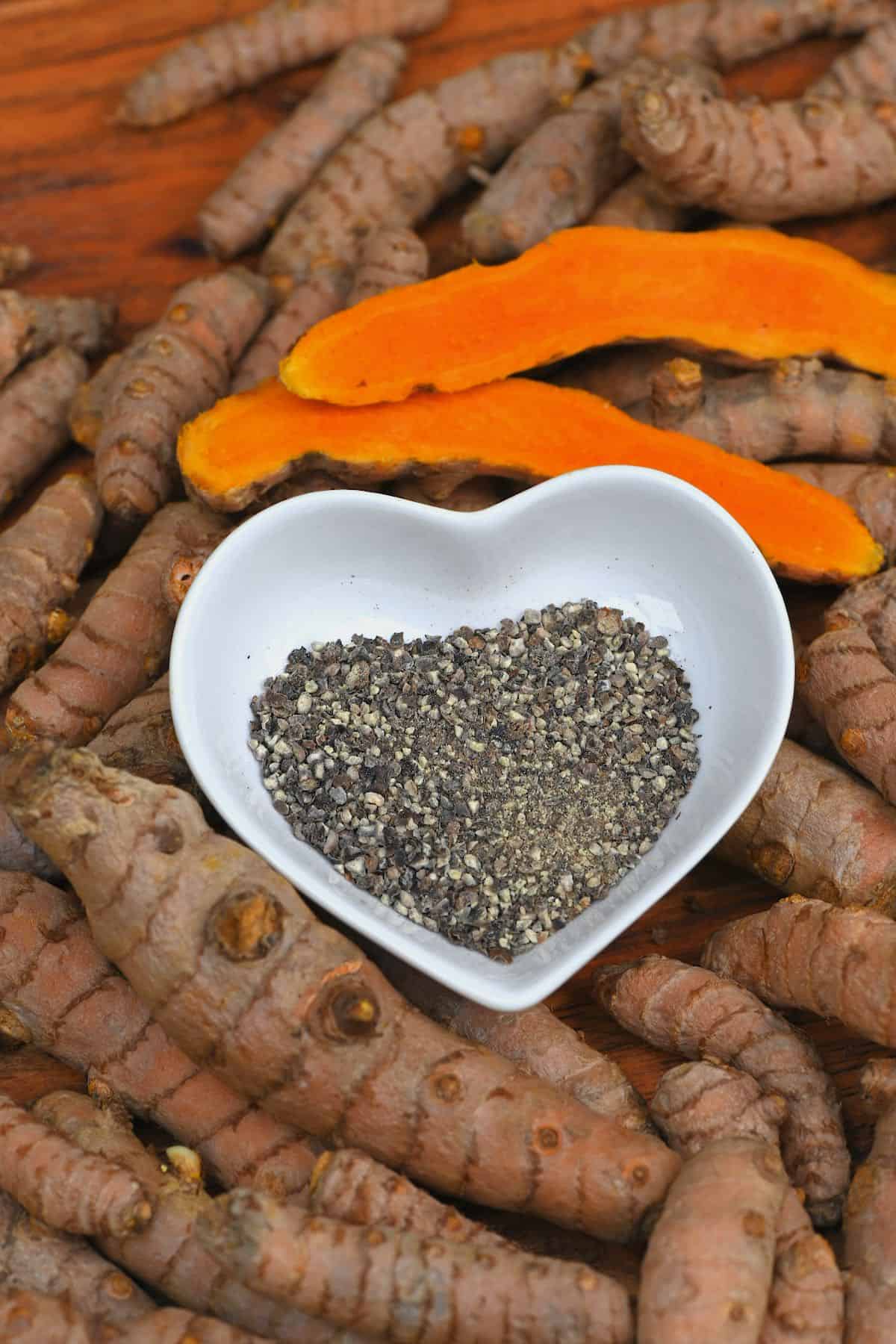
Want to save this recipe?
How to juice turmeric
With A Juicer
This method is the simplest and quickest, with the highest juice yield and lowest ‘waste’.
First, wash the fresh turmeric well using a small vegetable brush. There’s no need to peel the skin from the turmeric (unless you’re worried about pesticides), so I like to make sure that it’s properly clean.
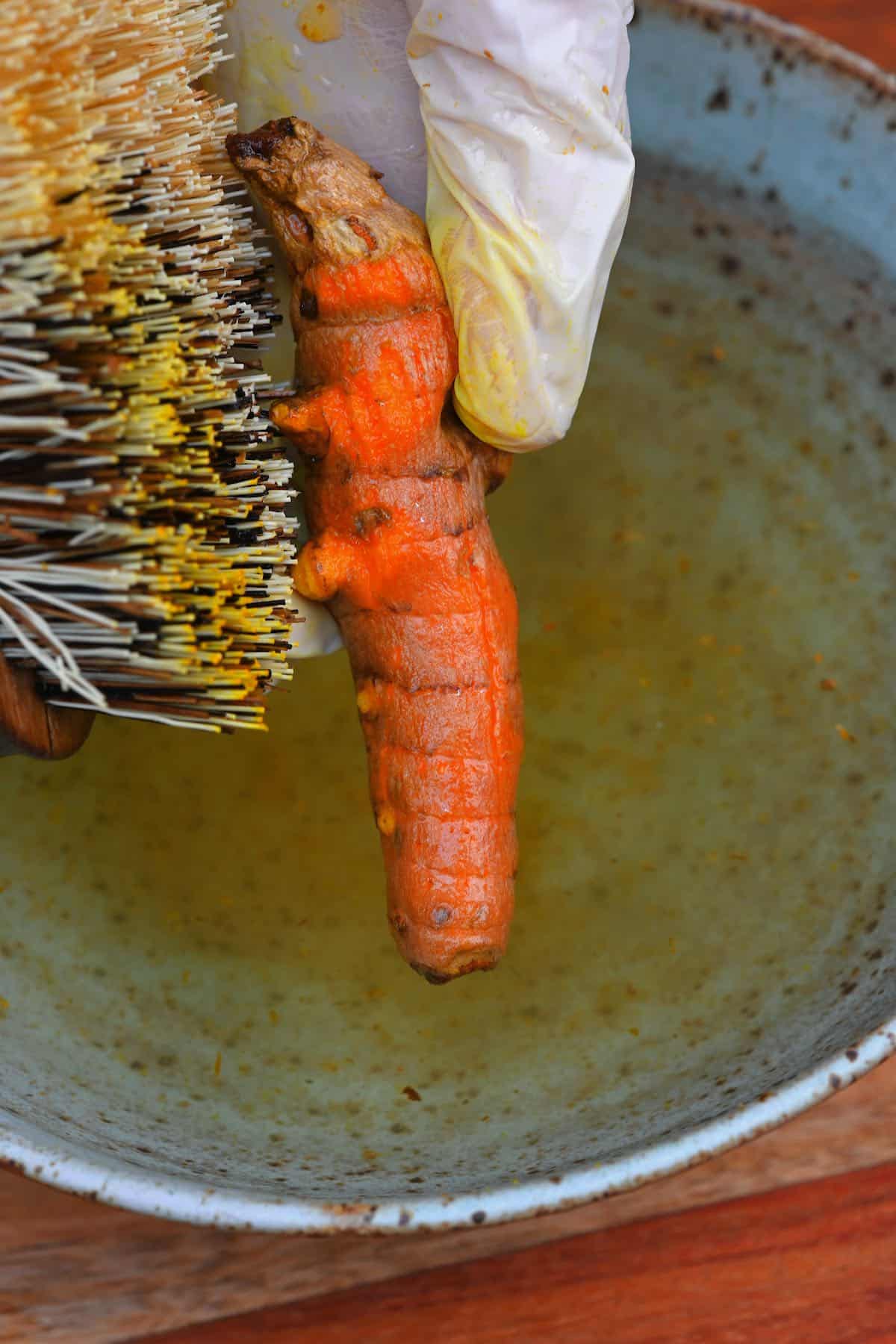
Then, feed the turmeric root into the juicer, cutting it into smaller pieces as needed to fit into your juicer’s shute.
Top Tip: If you find that the turmeric pulp is still very wet, you can actually feed it back through the juicer a second (and even third) time.
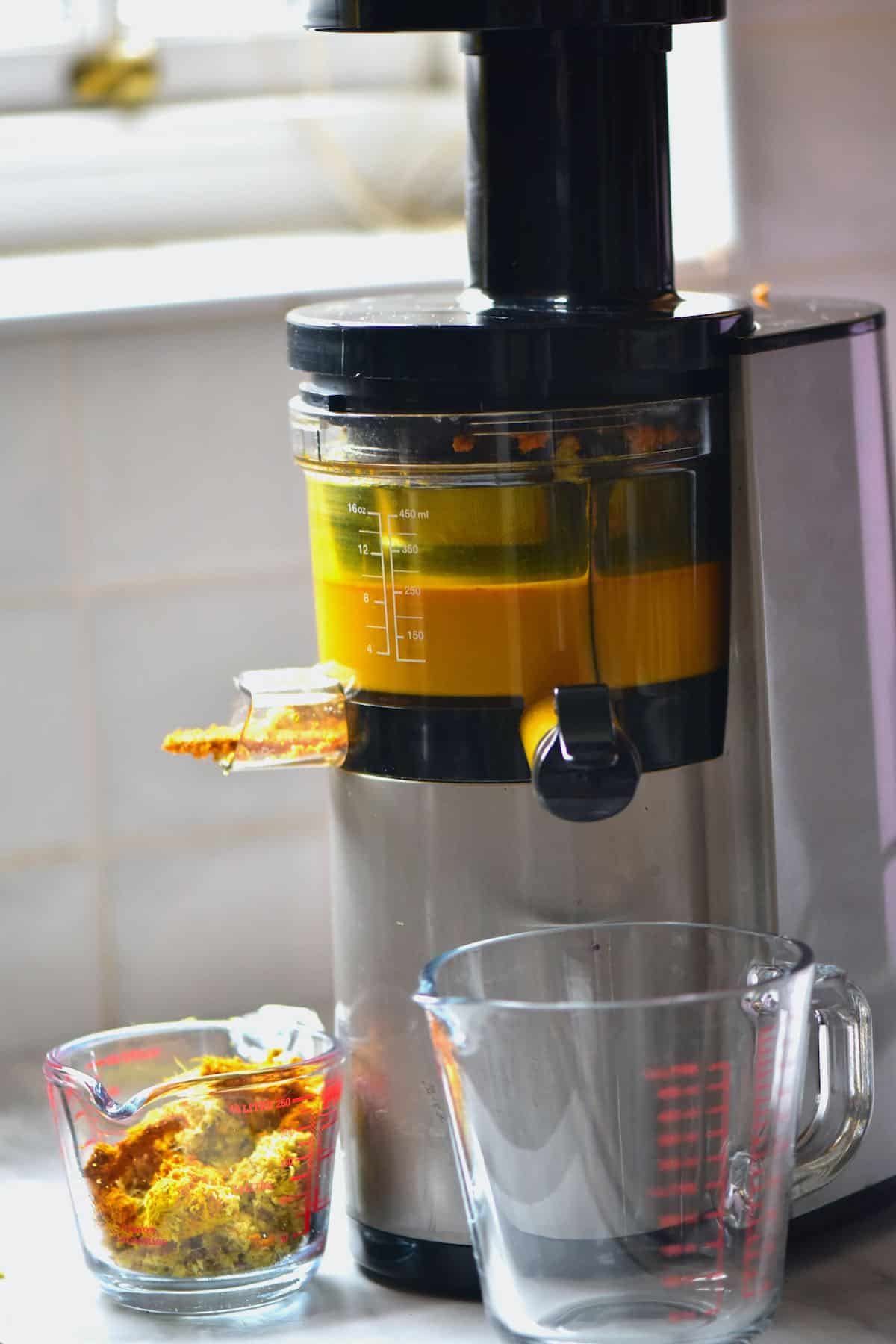
With A Blender
The main difference with this method is that you’ll need to add extra water to help the blender (high-speed blenders only!) create a juice – so the liquid is slightly diluted. You also won’t be able to extract quite as much from the turmeric root.
Top Tip: Use a smaller jug for this, as it will make it easier for the blade to blend the root properly.
For this, you can use un-peeled turmeric, though peeled may be easier to blend. The easiest way to peel turmeric root is with a spoon (like I have here for ginger), which will easily scrape it off.
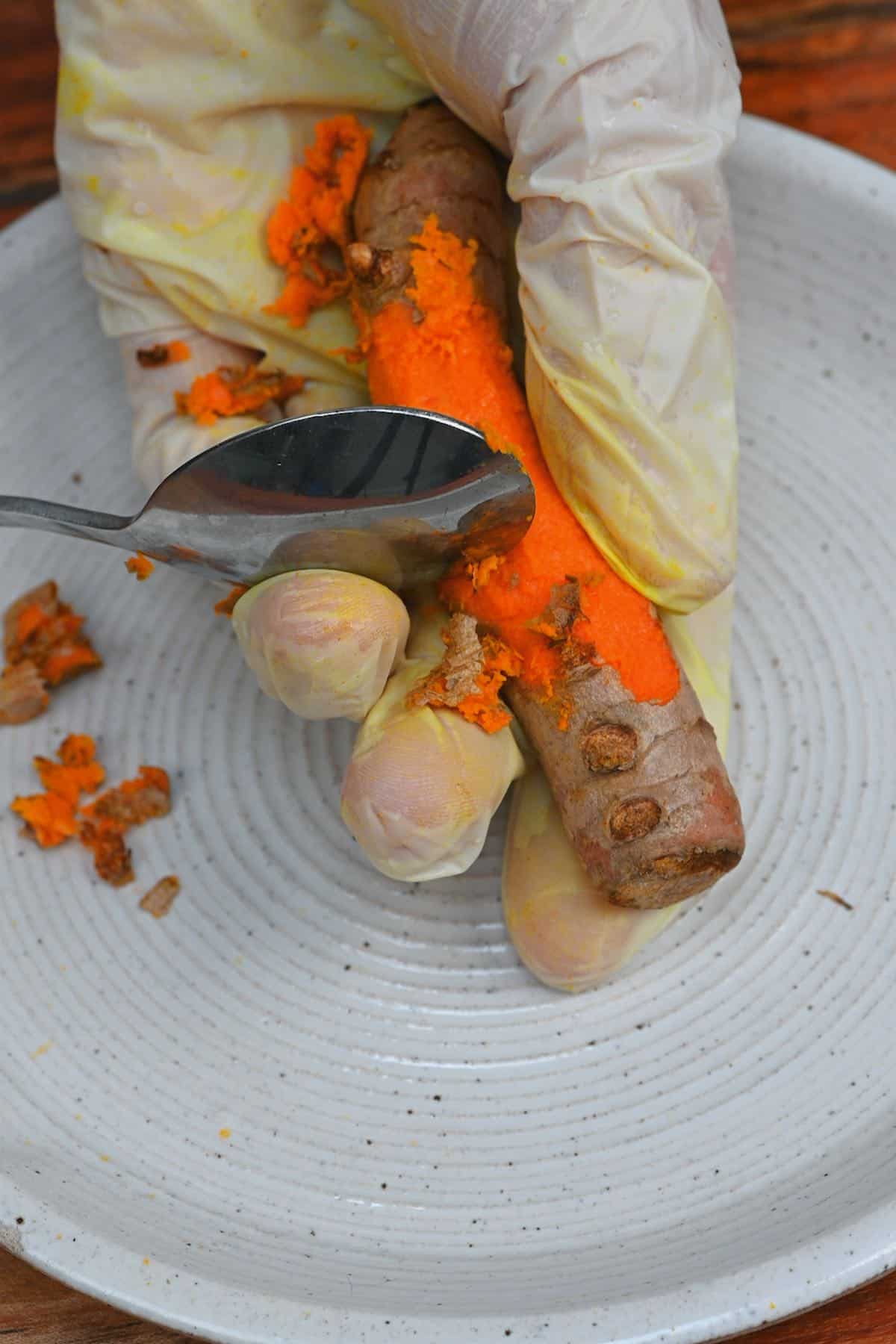
Chop the turmeric into small pieces around 1-inch in length/thickness and add to the blender with 1/2-1 cup of water and blend until the pieces are broken up, and you have a smooth-ish juice.
You could also use coconut water or blend it with another juice (like orange juice or carrot juice) if you want to use it immediately for mixed juice shots.
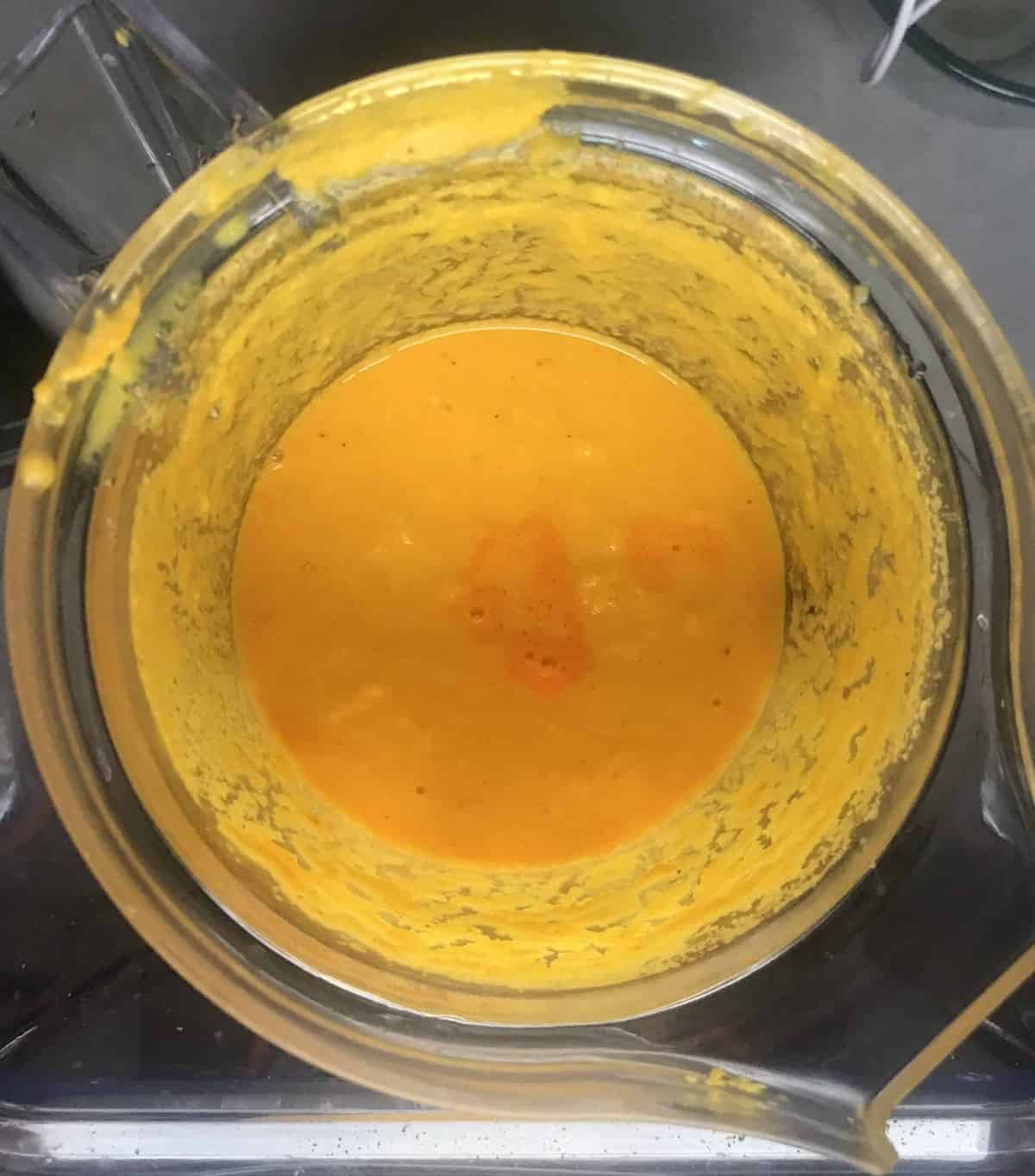
Then, pour the turmeric juice into a nut milk bag (or use a cheesecloth or sieve) and squeeze the pulp to extract as much juice as possible.
The juice will stain the nut milk bag/cheesecloth – so I usually keep one aside specifically for turmeric.
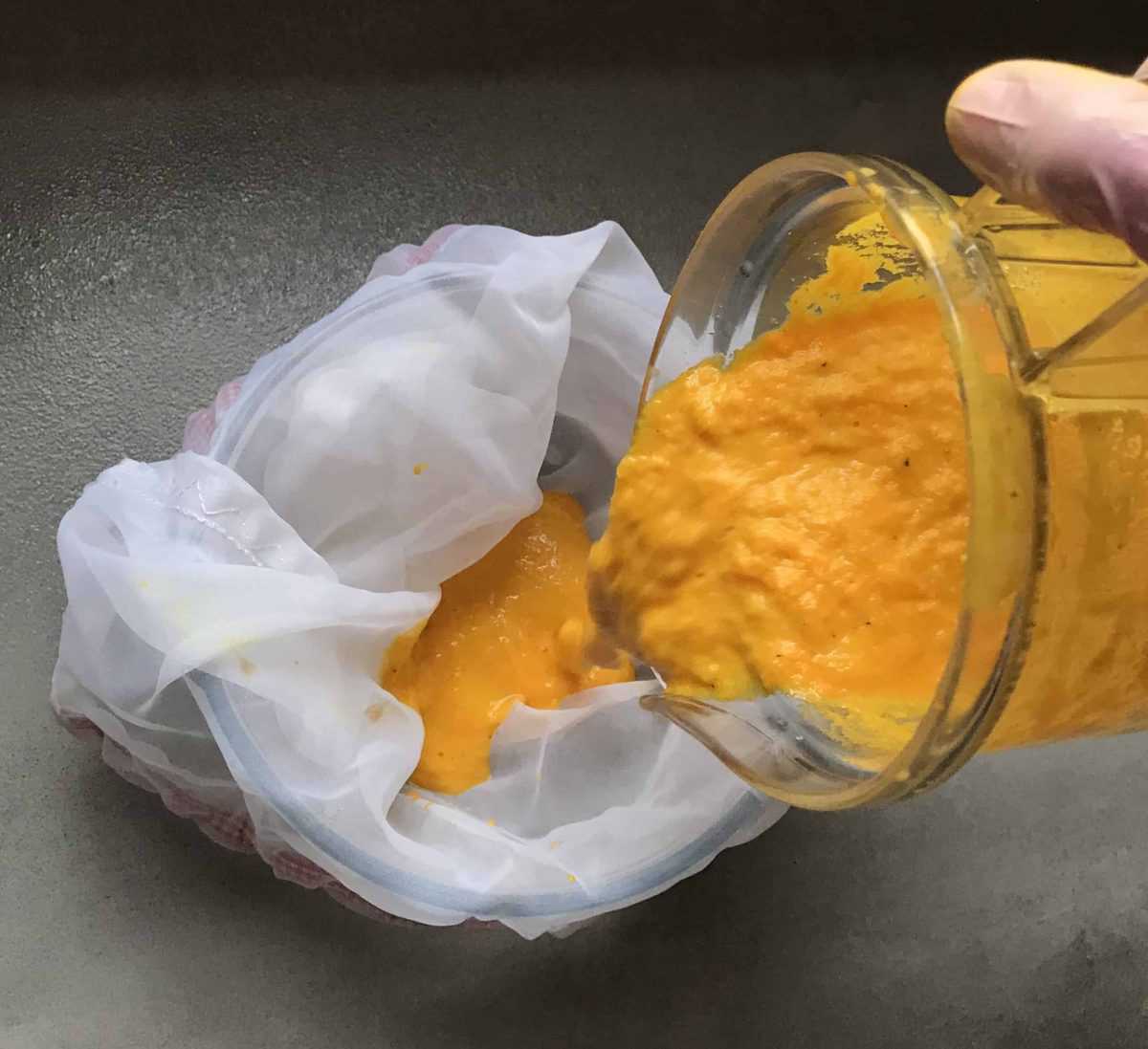
With A Garlic Press
This process can be affected by the turmeric’s age and the individual press – larger ones may work better- so it isn’t foolproof, but it should work in a pinch.
First, peel the turmeric root and then slice it into pieces about 1-inch in size (or just big enough to fit your garlic press.
Then simply press and the juice should come out without pushing through any of the pulp.
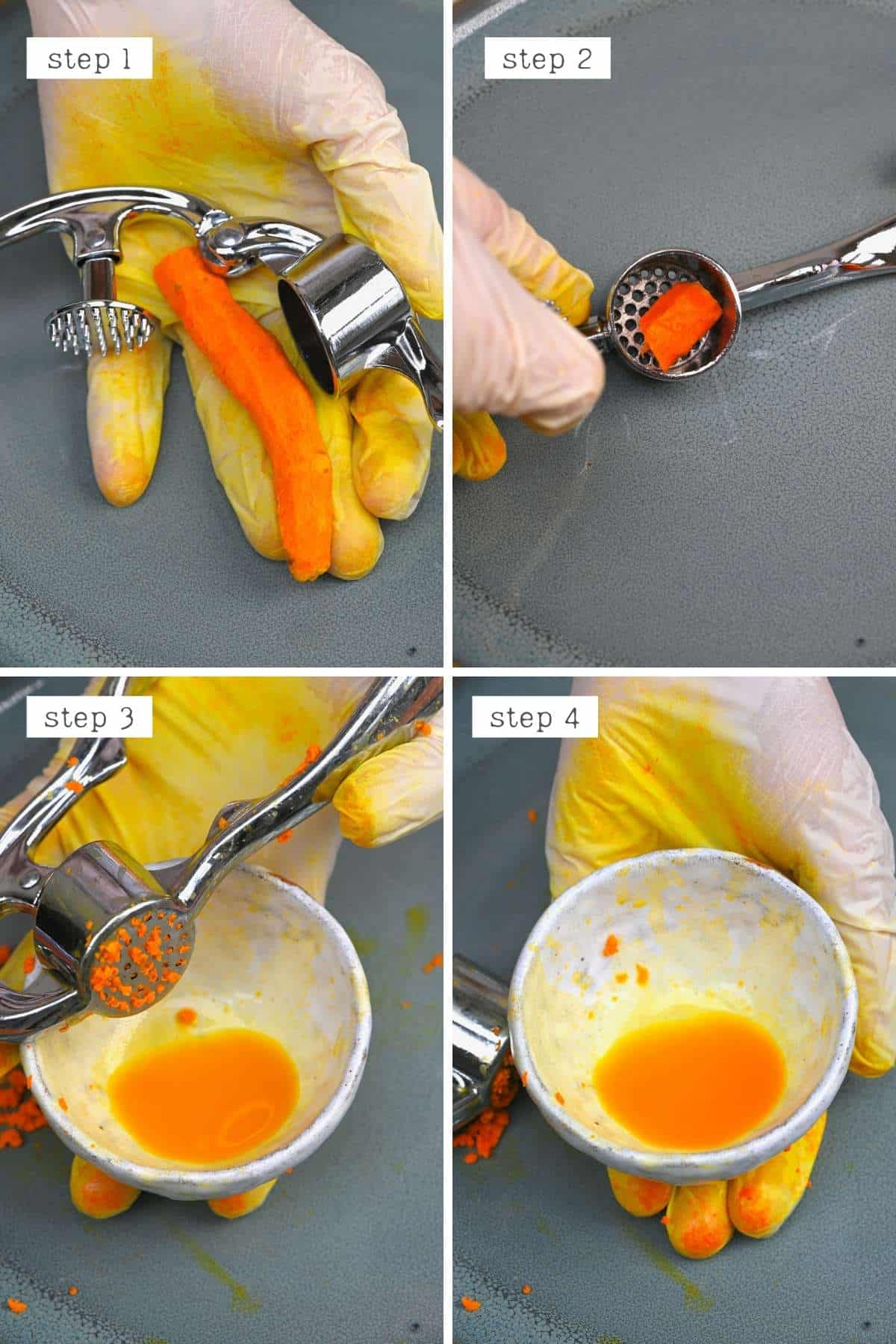
With A Garlic/Ginger Grater Dish
The final process only requires a garlic grater dish or micro planer/Japanese ginger grater and some patience. It will yield the most diluted juice – but it could be handy for those with no other option. Use gloves when using this method!
You can use peeled or unpeeled turmeric for this method.
First, grate the turmeric using the garlic grater.
You can then attempt to add the pulp to a nut milk bag and squeeze out as much juice as possible. Alternatively, add the pulp to some water.
Leave this to ‘soak’ in the refrigerator for at least six hours or overnight. Then strain the liquid through a nut milk bag/cheesecloth/strainer, pressing the pulp to extract as much juice as possible.
How to store
Fridge: Fresh juice is best consumed as soon as possible as the nutrients will deplete as it oxidizes. For that reason, it’s best to use the turmeric juice within 5-7 days, though it should be ‘fresh’ for up to 2 weeks. Give it a good shake before drinking.
Freezer: Pour the turmeric juice into an ice-cube tray for perfectly portioned amounts and freeze for up to 6 months. When you want to use some, remove it from the freezer and allow it to thaw for juice shots or blend directly into smoothies from frozen.
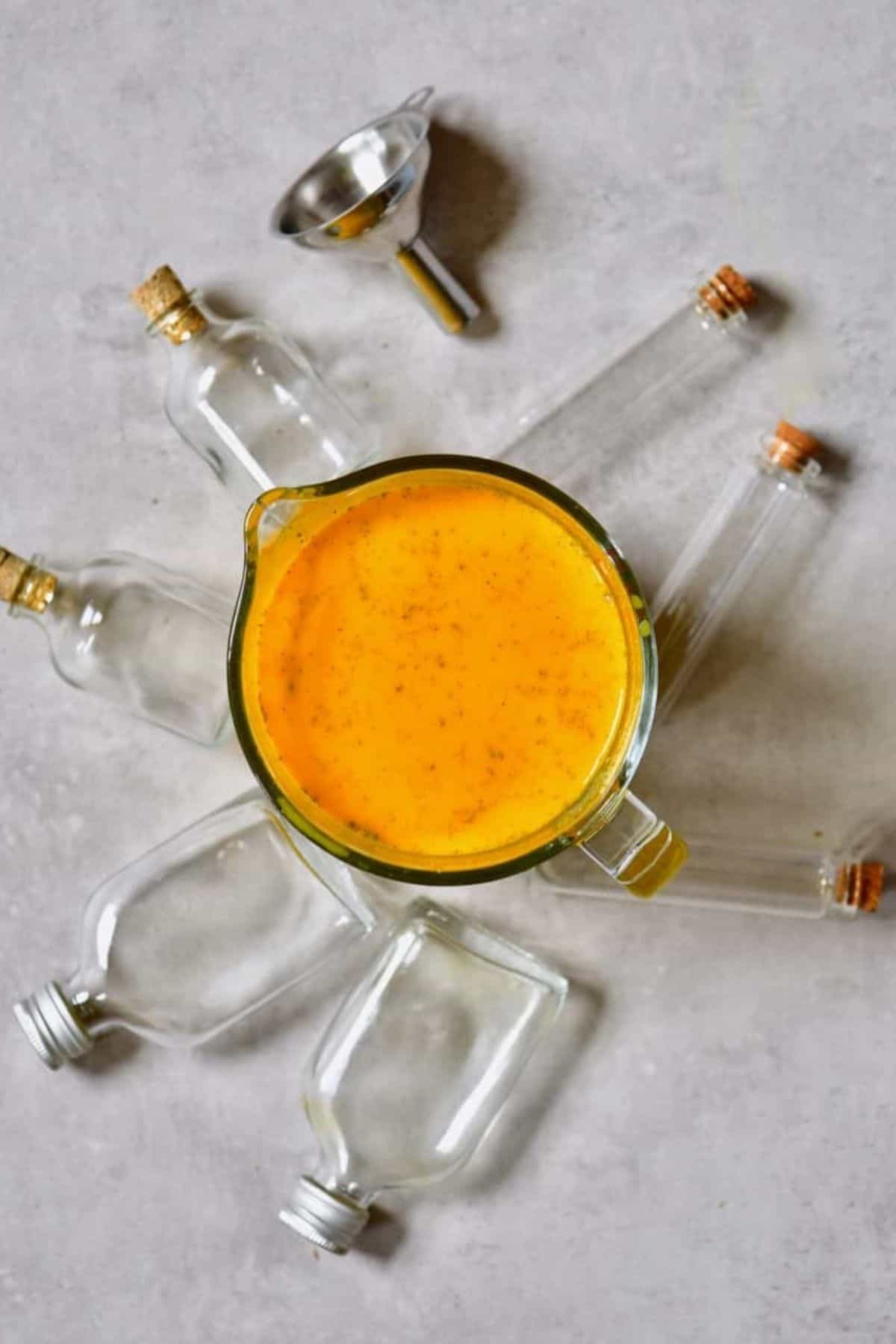
FAQs
How do you use turmeric pulp?
There are several ways you can utilize the leftover turmeric pulp.
- Freeze the pulp: it can then be added to soups, smoothies, tea, etc. You could even add a little of the juice with the pulp.
- Dry the pulp: lay it out on a tray and air-dry or use a dehumidifier and dry it out. Once dry, you can grind it into a blender or electric coffee/spice grinder until it’s powdered. It can then be added to baked goods and dishes for fiber, flavor, and added nutrition.
- To make turmeric tea: this is traditionally made with turmeric paste; however, you could also use turmeric pulp – just use a little extra.
- You can also use it in various recipes, such as crackers, muffins, or bread.
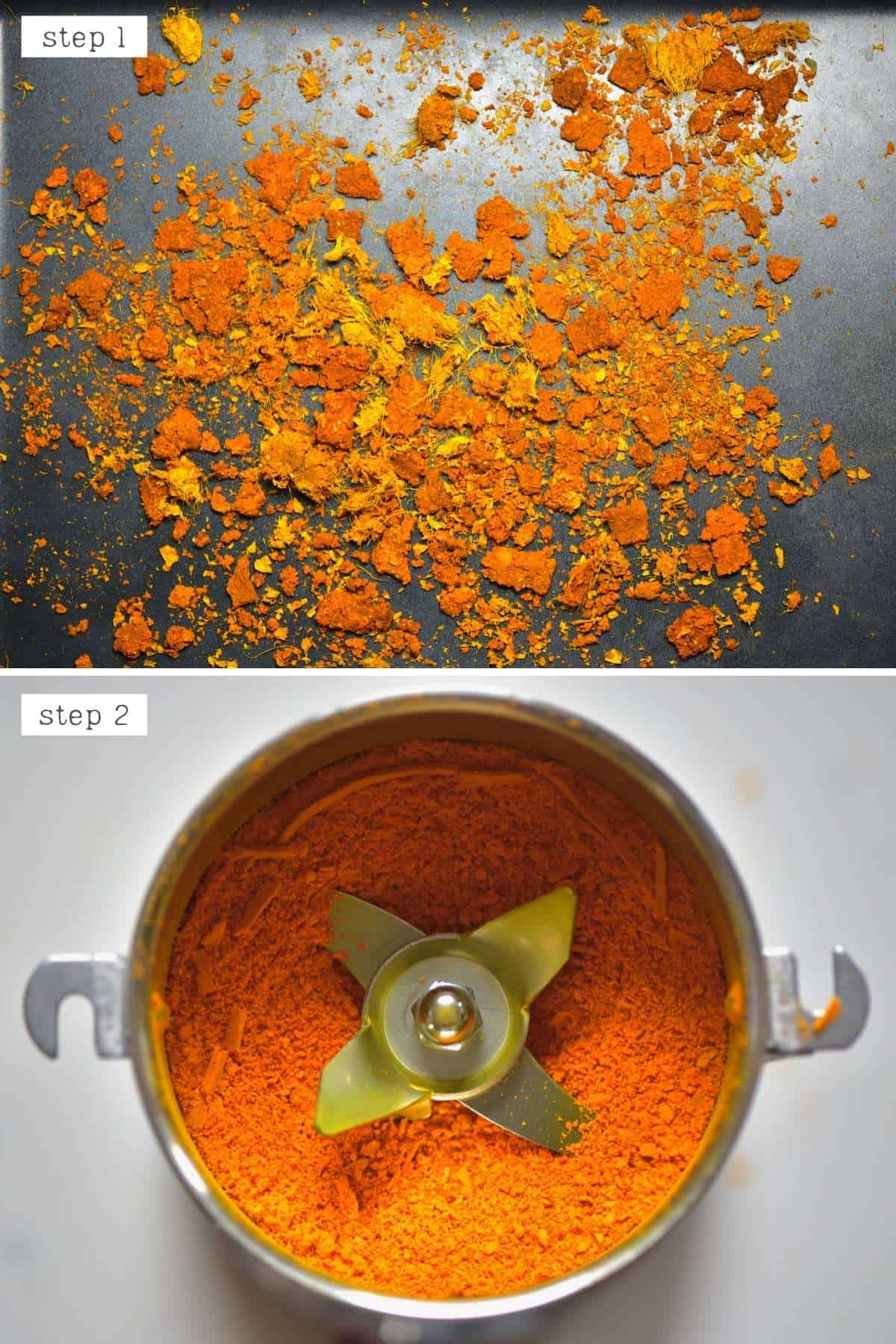
How Much turmeric juice should you have per day?
Apparently, you can safely consume up to 12,000mg of curcumin, but that’s definitely not something I’d recommend. Instead, several studies used amounts between 500-2000mg per day (though they usually use extracts with a higher curcumin amount).
Apparently, there is about 200mg of curcumin per 1tsp turmeric powder (3g). In general, when converting dried to fresh, you use 3x the amount – so 9g of fresh root per 200mg.
Furthermore, 2-inches of root equals around 1 Tbsp dried powder (9g powder so around 600mg curcumin).
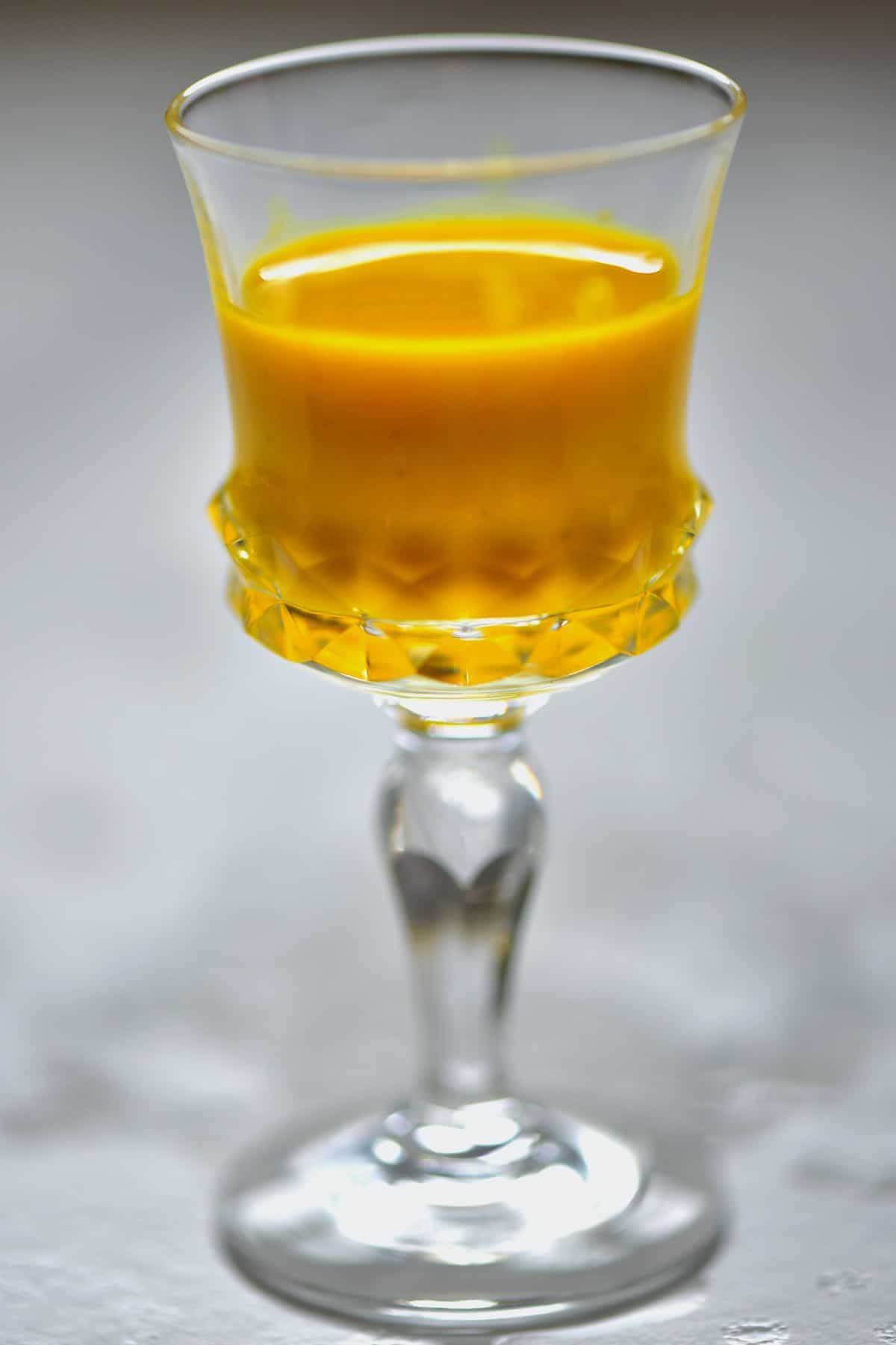
When is best to drink turmeric juice?
If you’re consuming as part of a shot, I usually suggest doing so in the morning on an empty stomach. However, you can add this juice to juice blends and smoothies at any time of the day.
If you experience any heartburn when drinking the juice on an empty stomach, consume it with food.
What juicer is best for juicing turmeric?
There are two main types of juicers: masticating and centrifugal. When it comes to turmeric, masticating (cold-press) will do a better job at extracting as much liquid as possible from the root.
Do you need to peel turmeric to juice it?
This is really down to personal preference. If you’re worried about pesticides, then you can. But most of the time (and with most methods), it’s definitely not necessary.
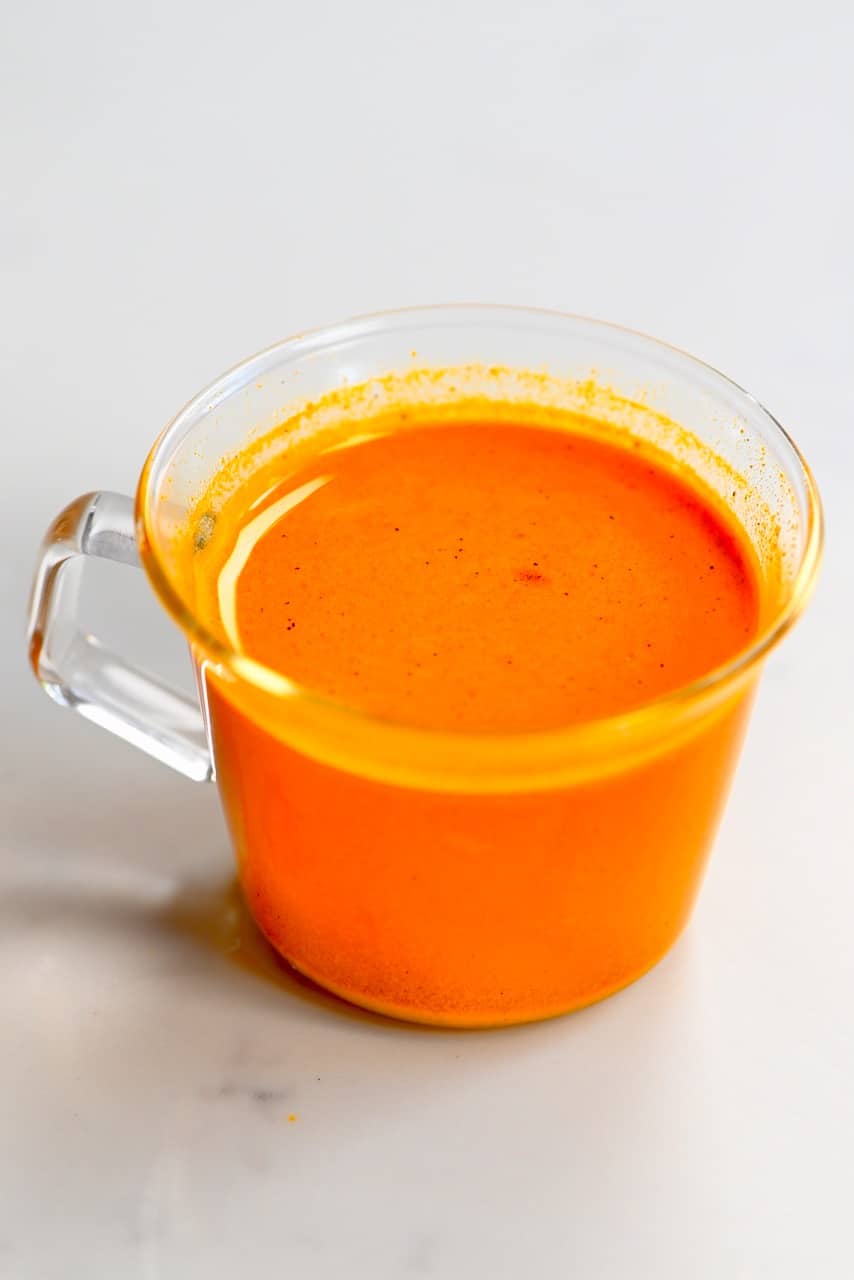
TOP TIPS
- TURMERIC WILL STAIN kitchen tools, wooden spoons, cutting boards, and skin! It’s best to use gloves when handling it and washing everything immediately after using. Once cleaned, place the items in a sunny window for 5-6 hours, and the turmeric stains fade away.
- Remember curcumin needs to be taken alongside black pepper and/or fat (such as coconut oil, butter, etc.). One study showed that just a pinch of black pepper served with turmeric increases the bio-availability by 2000%! So definitely not something to ignore.
- It’s best to use whole black pepper as the active element in the pepper oxidizes when exposed to light and air. Thus, it degrades over time.
Other turmeric DIYs & recipes
- DIY Turmeric Tincture – Nature’s Golden Medicine
- Simple Turmeric Honey Paste (+ Uses)
- How to make Turmeric powder at home
- Ginger Turmeric Immune-Boosting Energy Shots (juicer recipe)
- How to Remove Turmeric Stains (From Counters, Kitchen Gadgets, Clothes, etc.)
There are several other recipes here on the blog that include turmeric, so please check them out!
If you make turmeric juice, then let me know your thoughts and questions in the comments. I’d also really appreciate a recipe rating and would love to see your turmeric shots – just tag @AlphaFoodie.
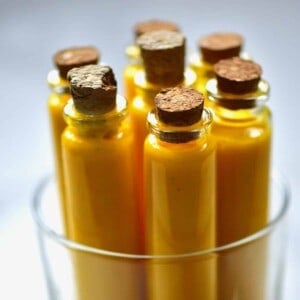
How To Juice Turmeric (With and Without a Juicer)
Equipment
Ingredients
- 9 oz turmeric or as much as you'd like to make
Instructions
With A Juicer
- (This method is the simplest and quickest, with the highest juice yield and lowest 'waste'.)Wash the fresh turmeric well using a small vegetable brush. There's no need to peel the skin from the turmeric (unless you're worried about pesticides), so I like to make sure that it's properly clean.
- Feed the turmeric root into the juicer, cutting it into smaller pieces as needed to fit into your juicer's shute.Top Tip: If you find that the turmeric pulp is still very wet, you can actually feed it back through the juicer a second (and even third) time.
With A Blender
- The main difference with this method is that you'll need to add extra water to help the blender (high-speed blenders only!) create a juice – so the liquid is slightly diluted. You also won't be able to extract quite as much from the turmeric root.For this, you can use un-peeled turmeric, though peeled may be easier to blend. The easiest way to peel turmeric root is with a spoon (like I have here for ginger), which will easily scrape it off.Chop the turmeric into small pieces around 1-inch in length/thickness and add to the blender with 1/2-1 cup of water and blend until the pieces are broken up, and you have a smooth-ish juice.Top Tip: Use a smaller jug for this, as it will make it easier for the blade to blend the root properly.You could also use coconut water or blend it with another juice (like orange juice or carrot juice) if you want to use it immediately for mixed juice shots.
- Pour the turmeric juice into a nut milk bag (or use a cheesecloth or sieve) and squeeze the pulp to extract as much juice as possible.The juice will stain the nut milk bag/cheesecloth – so I usually keep one aside specifically for turmeric.
With A Garlic Press
- This process can be affected by the turmeric's age and the individual press – larger ones may work better- so it isn't foolproof, but it should work in a pinch.Peel the turmeric root and then slice it into pieces about 1-inch in size (or just big enough to fit your garlic press).Then simply press and the juice should come out without pushing through any of the pulp.
With A Garlic/Ginger Grater Dish
- The final process only requires a garlic grater dish or micro planer/Japanese ginger grater and some patience. It will yield the most diluted juice – but it could be handy for those with no other option. Use gloves when using this method! You can use peeled or unpeeled turmeric for this method.Grate the turmeric using the garlic grater.Then add the pulp to a nut milk bag and squeeze out as much juice as possible.Alternatively, add the pulp to some water. Leave this to 'soak' in the refrigerator for at least six hours or overnight. Then strain the liquid through a nut milk bag/cheesecloth/strainer, pressing the pulp to extract as much juice as possible.
How To Store
- Fridge: Fresh juice is best consumed as soon as possible as the nutrients will deplete as it oxidizes. For that reason, it's best to use the turmeric juice within 5-7 days, though it should be 'fresh' for up to 2 weeks. Give it a good shake before drinking.Freezer: Pour the turmeric juice into an ice-cube tray for perfectly portioned amounts and freeze for up to 6 months. When you want to use some, remove it from the freezer and allow it to thaw for juice shots or blend directly into smoothies from frozen.
Notes
Nutrition
Nutrition information is automatically calculated, so should only be used as an approximation.











Hi. Is there a way to know how much curcumin is in juice made from 5 fingers of turmeric? My mother is on blood thinners and when she had turmeric juice for three days in a row her platelet count dropped by more than half. Went right back up after she stopped drinking the juice. I’m wondering if there is a way to know how much curcumin was in that and then how much would be safe for her.
Hello,
The curcumin content can vary widely depending on the variety of turmeric, growing conditions, processing method. You’d also need to measure how much you use by weight. On average, turmeric root contains about 2-5% curcumin by weight.
In any case, it’s best to consult with a medical professional to see if it’s safe for your mother to continue any turmeric. I hope this helps.
Hi, how can I calculate the quantity or percentage of curcumin in this juice? Without adding water, I mean, as I’m just using pure juice extracted from the root in a powerful juicer. Thanks.
Hi there,
It’s difficult to calculate the percentage of curcumin outside of a lab. It can vary a lot depending on many factors – the type of turmeric, how it’s grown, how it’s juiced, etc.
It’s estimated that 9 oz of turmeric (250 g) has about 2-6% curcumin (which is about 5-15 g of curcumin). Seeing as some of the curcumin could stay in the pulp, there’s even less in the juice.
Please keep in mind that this is a rough estimate. I hope this helps.
“Thanks for sharing this process, I am definitely going to try this. Turmeric is widely used in Ayurveda (Ancient Indian Medication). I learned about turmeric from iahas.com, and since then, I have been a big fan of this spice. I will add your blog to my list.
Keep posting such great stuff.”
Thank you for your comment, Jesse!
Thank you for the Tumeric information. I have inflamation and seeking recipes using Tumeric combat the joint pain..
Thank you for your comment, Cassandra. Hope you are enjoying the turmeric juice.
hi I realised you use kuvings for this. how did you wash it as I tried using kuvings and the whole thing stained terribly as the pulp becomes quite rocky and hard. also the strainer has gluey stain all over it. just curious and thank you!
Hi Kylie,
It’s a different brand of juicer – I always make sure to clean it as soon as possible after juicing turmeric. I have a lot more tips on this post: https://www.alphafoodie.com/how-to-remove-turmeric-stains/
I hope this helps.
Great article. I’ve been using Turmeric from time to time but now I saw informacion regarding people with iron deficiency. Why is Turmeric not good in this case?
And what can happen if a person with iron deficiency takes Turmeric?
Hi Anna,
Turmeric could interfere with the absorption of iron in the body. If you are wondering whether you can consume turmeric, it’s best to consult with a medical professional.
Hi! Don’t you get the yellow turmeric sticking everywhere including your blender, cheese cloth, glove, etc? I don’t really know how to clean this mess up after the juicing session. It was so difficult and they stuck for days.
Hi Albert,
Indeed, turmeric can easily stain everything. I always wash my tools and juicer as quickly as possible. I recommend using gloves to protect your hands. There are a lot more tips on this blog post:
https://www.alphafoodie.com/how-to-remove-turmeric-stains/